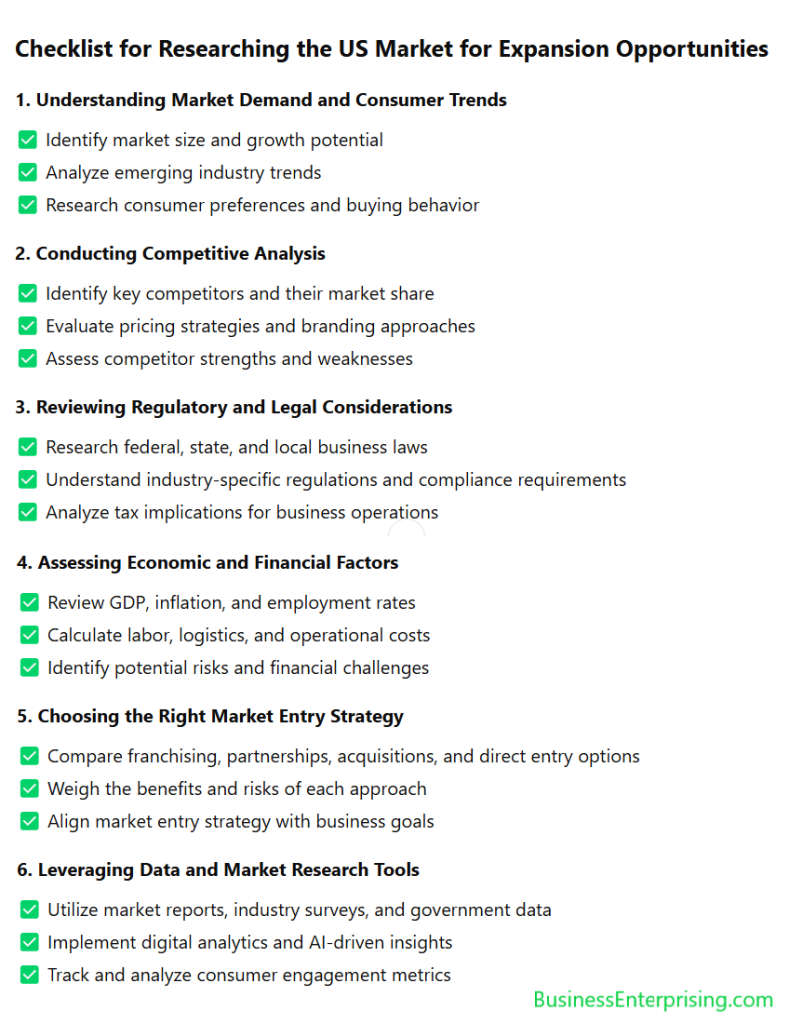
Understanding Market Demand and Consumer Trends
When researching the US market for expansion opportunities, it’s essential to grasp current market demand and consumer trends. Analyzing market size involves assessing the total sales volume within your target industry. This helps you understand the scale of opportunity available. Growth potential indicates how much the market is expected to expand. Emerging trends, such as the rise of sustainable products and the integration of artificial intelligence in services, can signal new areas for investment. By staying informed about these developments, you can position your business to meet evolving consumer needs.
Identifying consumer preferences requires examining purchasing behaviors and lifestyle choices. For instance, many consumers now prioritize brands that demonstrate environmental responsibility. Additionally, the demand for personalized shopping experiences has increased, with shoppers expecting tailored recommendations and services. Understanding these preferences allows you to tailor your offerings effectively. Moreover, recognizing shifts in spending habits, such as a move towards online shopping or a preference for local products, can inform your market entry strategy.
Furthermore, it’s important to consider demographic factors that influence buying behaviors. Different age groups may have varying priorities; younger consumers might value innovation and sustainability, while older demographics could focus on quality and reliability. By segmenting the market and analyzing these groups, you can develop targeted marketing strategies. Therefore, a comprehensive understanding of consumer trends and market demand is crucial for successful expansion into the US market.
Competitive Landscape Analysis
When researching the US market, it’s important to conduct a thorough competitive landscape analysis. Start by identifying your key competitors. Look for companies offering similar products or services. Consider both direct and indirect competitors. Direct competitors provide the same offerings, while indirect ones meet the same customer needs differently. Understanding who your competitors are helps you assess your position in the market.
Next, evaluate their market share. Determine how much of the market each competitor controls. This insight reveals their influence and dominance. Various methods, like analyzing sales data and industry reports, can assist in this assessment. Knowing their market share helps you gauge the competitive intensity.
Additionally, analyze their pricing strategies. Observe how they price their products or services. Are they competing on price, or do they offer premium options? Understanding their pricing approach can inform your own strategy. It also highlights potential areas where you can differentiate.
Branding is another critical aspect to examine. Assess how competitors position themselves in the market. Look at their messaging, visual identity, and customer engagement. Strong branding can create customer loyalty and set a company apart. By understanding their branding efforts, you can identify gaps and opportunities for your brand.
Furthermore, identify their unique value propositions. Determine what makes their offerings stand out. This could be superior quality, exceptional service, or innovative features. Knowing their unique selling points helps you understand what customers value. It also guides you in developing or highlighting your own strengths.
By thoroughly analyzing these aspects, you can develop strategies to differentiate your business. This approach positions you effectively against competitors in the US market. It also helps you identify opportunities to meet unmet customer needs.
Regulatory and Legal Considerations
When researching the US market, it’s important to understand the regulatory and legal considerations involved. You must navigate federal, state, and local business laws. Each level of government imposes its own regulations. Therefore, compliance requires careful attention to detail.
At the federal level, businesses must adhere to laws such as the Corporate Transparency Act, which mandates disclosure of beneficial owners to the U.S. Treasury Department. This law aims to prevent financial crimes. Additionally, industry-specific regulations may apply. For example, environmental laws affect manufacturing processes. Therefore, understanding the regulations pertinent to your industry is essential.
State and local laws add another layer of complexity. Each state has its own set of business regulations. These can include licensing requirements, employment laws, and zoning ordinances. For instance, some states have stricter environmental regulations than others. Therefore, it’s important to research the specific laws in the states where you plan to operate.
Tax implications also vary across jurisdictions. The federal corporate tax rate is currently a flat 21%. However, state and local taxes differ widely. Some states impose additional corporate income taxes, while others do not. Additionally, certain industries may be subject to excise taxes. Therefore, consulting with a tax professional can help you navigate these complexities.
In summary, understanding the regulatory and legal landscape is crucial when entering the US market. By thoroughly researching and complying with applicable laws, you can establish a solid foundation for your business operations.
Assessing Economic and Financial Factors
When researching the US market, it’s important to assess economic and financial factors. Begin by evaluating key economic indicators such as Gross Domestic Product (GDP), inflation, and employment rates. A growing GDP suggests a healthy economy, while stable inflation indicates controlled price increases. Additionally, low unemployment rates reflect a strong labor market. These metrics provide insight into the overall economic environment.
Understanding the costs of doing business is also essential. Labor expenses often constitute a significant portion of operational costs. According to the U.S. Bureau of Labor Statistics, labor costs can account for as much as 70% of total business costs. Therefore, analyzing wage levels and labor availability in your target area is crucial. Additionally, logistics costs, including transportation and warehousing, can impact profitability. In 2022, U.S. business logistics costs exceeded $2.3 trillion, highlighting the importance of efficient supply chain management. Operational expenses such as utilities, rent, and administrative costs vary by region and industry. Therefore, conducting thorough research will help you develop a realistic financial plan.
By carefully analyzing these economic indicators and cost factors, you can make informed decisions about entering the U.S. market. This approach enables you to identify potential challenges and opportunities, allowing for strategic planning and successful market entry.
Identifying Ideal Market Entry Strategies
When researching the US market, selecting the right entry strategy is essential. Options include franchising, partnerships, acquisitions, and direct entry. Each approach has its advantages and drawbacks.
Franchising allows you to expand with minimal capital investment. By granting rights to local operators, you can grow rapidly. However, maintaining brand consistency across franchises can be challenging. Additionally, less direct control over operations may lead to quality variations.
Partnerships offer access to local market knowledge and shared resources. Collaborating with established entities can ease market entry. Yet, aligning goals and managing relationships can be complex. Potential conflicts may arise if expectations differ.
Acquisitions provide immediate market presence and established customer bases. This strategy can accelerate growth and eliminate competitors. However, acquisitions often require substantial capital and carry integration risks. Cultural differences between organizations may hinder smooth transitions.
Direct entry involves establishing your own operations from scratch. This approach grants full control over business activities. While it allows for tailored strategies, it demands significant time and financial investment. Building brand recognition and customer loyalty may take longer.
In conclusion, each market entry strategy presents unique benefits and challenges. Careful consideration of your business objectives and resources will guide you to the most suitable approach.
Leveraging Data and Market Research Tools
When researching the US market, leveraging data and market research tools is essential. Utilizing market reports, industry surveys, and government data sources provides valuable insights. For instance, the U.S. Census Bureau offers comprehensive economic data across various sectors. Additionally, platforms like Statista aggregate statistics from multiple sources, offering a broad view of industry trends. These resources help you understand market dynamics and consumer behavior.
Implementing digital analytics and AI-driven insights further enhances decision-making. AI can analyze consumer behavior across various touchpoints, such as interactions with paid ads, email opens, website visits, and product behavior. By analyzing large datasets, AI identifies patterns and predicts future trends. This approach enables more informed strategic planning. Moreover, AI-driven tools can automate complex processes, increasing efficiency. Therefore, integrating AI into your market research strategy can provide a competitive edge.
Combining traditional data sources with advanced analytics offers a comprehensive market understanding. While market reports and surveys provide foundational knowledge, AI uncovers deeper insights. This synergy allows for more accurate forecasting and effective strategy development. Consequently, businesses can respond swiftly to market changes and consumer preferences. Incorporating these tools into your research process enhances your ability to make data-driven decisions.
Conclusion
When researching the US market, thorough analysis is essential. By understanding market demand, analyzing competition, and considering regulatory factors, you can make informed decisions. Additionally, selecting the right market entry strategy and leveraging data tools will enhance your success. Therefore, a comprehensive approach positions your business for effective expansion into the US market.



